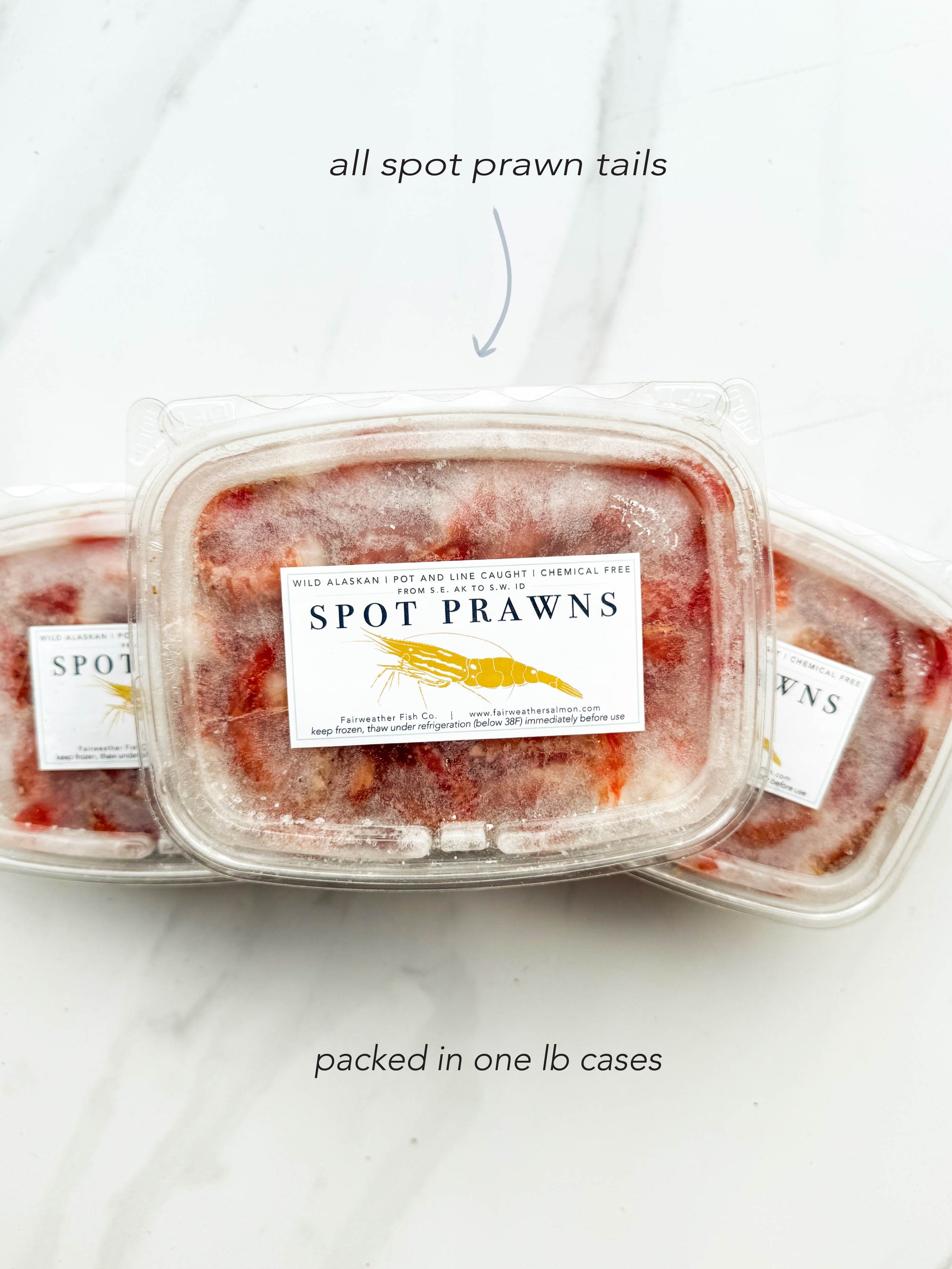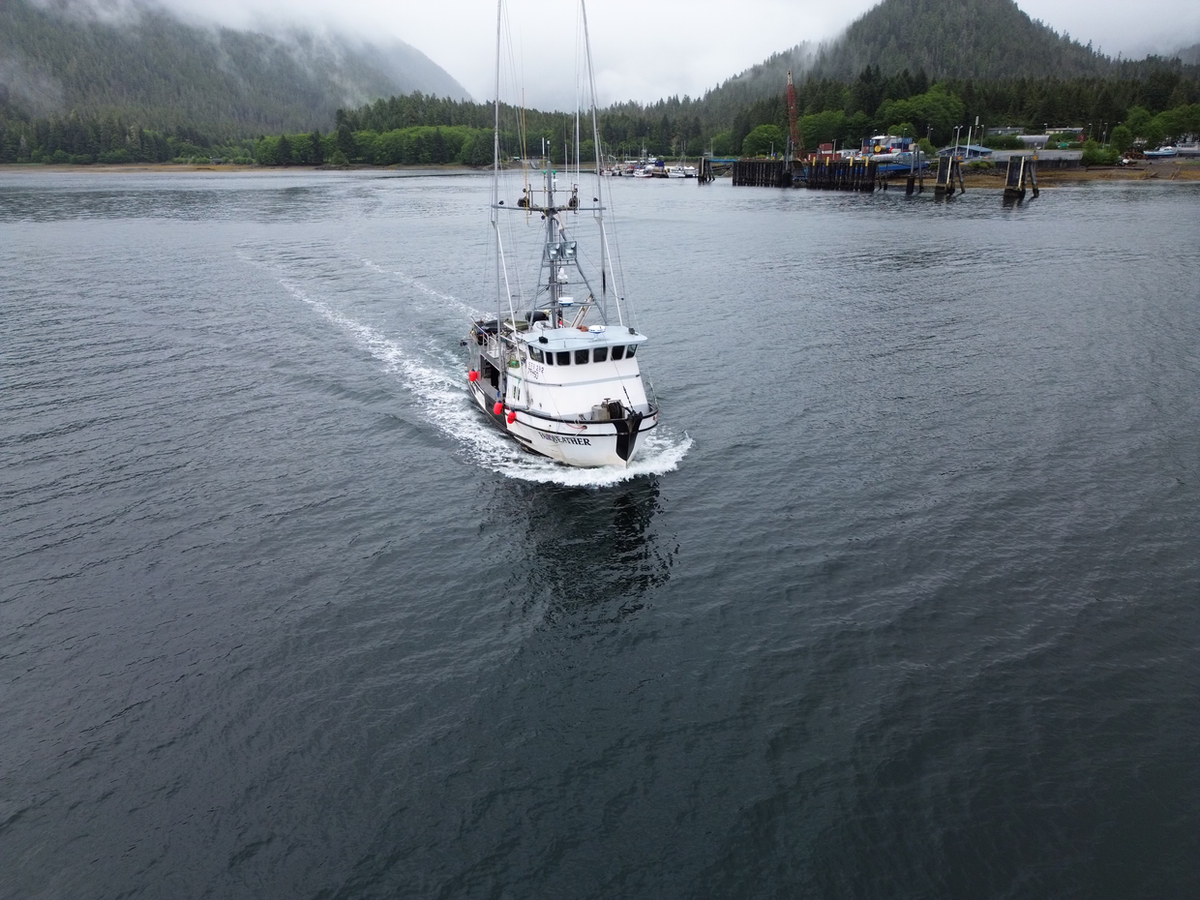
Spot Prawn Season 2025 🦐
They're succulent, they're sweet, they're beautiful and tasty. Spot prawns are maybe our favorite fish - both to make for dinner, and to harvest for a living. In Southeast Alaska, the spot prawn fishery opens on May 15 of each year. It's our first fishery of the season, and the perfect one to break the boat (and us!) in.

Shrimping has good rhythm - it can be tiring, but it's not too tiring. It gets you out on the water, but not out on the open, wavy sea. And it gives the promise of structure: a rare and tender mercy for a commercial fisherman. Pots can only be pulled from 8 a.m. to 4 p.m.; meaning we are all typically cozily tucked into our bunks by 9 p.m. each night.
Around May 10th, Caleb, Danya, and Jake had the boat loaded with all the pots, buoy, line, bait, packaging supplies, and the 2+ weeks of groceries we'd need for our trip. It's about a day's run from our homeport of Sitka to the spot prawn grounds we fish. They had a smooth run down the coast, and Monti and I flew into the nearest airport to meet them there and hop aboard. By the night of May 13th, we were anchored up in our usual spot, eagerly awaiting the morning of the 15th.
One of the hardest parts about fishing is choosing where to fish, and that feels especially true for pot fishing. While dragging salmon hooks, we can change course and begin charging to new fishing grounds in fifteen minutes flat. Pot fishing is not so simple - once the pots are deployed, it would be a half day's work to get them all back on deck and move elsewhere. And then once you arrive at 'elsewhere', you hope that it's not already littered with other fishermen's pots, and that you'll have the time to learn the area before it closes down.
The Southeast Alaska Spot Prawn fishery is managed using a quota system. Southeast is divided into districts, and each district into statistical areas. Every district has it's own quota (allowable pounds of catch), to be caught on a first come first served basis. The more popular and productive districts generally only stay open for nine to twelve days - counting the days your ports are deployed - so every day really counts. Though we typically say "community over competition", in the case of these quota style fisheries, it's just plain competition. Every pound of shrimp in your neighbor's boat is in fact one less pound you're allowed to harvest. It's not personal or emotional, but it is math.

All that to say: tensions are high on opening morning. Caleb's wildly anxious to know if he chose the right geographical area to start in, and then once the fishing does start -- Jake and Danya are setting pots as fast as possible, so we can beat the other fishermen in that area to our "hot spots".
This year, the team set all 140 pots (totaling 28 strings at 5 pots each) in under three hours! Come opening morning, there were more boats than usual in our shared area, and that made it especially difficult to get the pots set. Some of our go-to spots we could claim, and others were already gridded with other fishermen's buoys by the time we arrived there.
And then the morning of the 16th came - the first day hauling pots - and we get to see whether all the handwringing, planning, anxiety, and hustling was worth it. By noon on the 16th, it was apparent. Fishing was okay, but not great. We caught only about 60% of what we'd hope to catch on opening day. The next day, our catch went down by about 10%. The following day, another 10%. That trend continued over the next week, and this opener began to feel quite dismal.
To top it all off, the weather was incredibly mean for May! It's been an unseasonably cold spring all over Alaska, but our little corner was getting continually pounded with storms. In the protected bays and inlets where we shrimp, waves don't have the chance to stack thankfully. But the wind does makes it difficult to pull pots, sometimes impossible if the gear was close to shore. It also makes for sleepless nights on anchor - sleeping with one eye open to listen for the radar alarm, which would alert us if the boat began to drag towards the rocky shoreline.
When the harvest rate isn't what you'd expect, the question always becomes: "should I stay, or should I go?" Caleb doesn't shy away from making the risky choice to seek better fishing grounds. But at the same time, one of our go-to mantras is: "stick and stay and make it pay". That's to say, even so-so fishing can pay the bills if you're willing to keep your head down and simply put in your time. And sometimes, chasing your tail searching for the next-best-bite can kill a season - especially a short one, like shrimping.
Eventually, mental health won. The toll of fishing around so much other gear, coming out in the morning to see buoys laced in between yours, was just too aggravating. So we did something we've never done before during a shrimp season: stacked all 140 pots plus their tens of thousands of feet of line on deck, and went in search of greener (if not at least less crowded) pastures.

We didn't move all that far, really -- just a few hours away. We started stacking gear on at 8 a.m. sharp, and had it all on deck by 11 a.m. Given the limited set-and-haul hours, we weren't able to get all 140 pots back in the water by 4 p.m., but we did get most. The day we moved gear was actually the one gloriously sunny and beautiful day of the season! So beautiful, in fact -- that we had no idea it would gust 50 mph the next day, making most of what we had moved and re-set difficult or impossible to haul for the next three days.
Now that it's all said and done, it's tough to say if the move paid off. We thought the weather was tricky the first half of the opener... It really got with it in the second half. Initially, our already dismal catch rate further dropped when we moved. But rather than continuing to decline each day, it steadily increased. And thankfully, everyone else in our district must have been doing as poorly as we were, because while our district typically stays open for nine to ten days, this year we were granted sixteen days! Even with almost 40% more days on the water, our overall catch came in at about 30% less than we'd expect on an average year.
It tough to say "why" this spring was such an odd one. Perhaps there was simply too much competition for the same shrimp, or maybe the stock is experiencing a low abundance year. Some years are just odd, too - and there's not always a clear cut answer. It was still a profitable endeavor though, and we had a lot of fun. Good family memories made, incredible crew and friends aboard, and good shrimp for dinner at night. There's much worse ways to make a living.
I'll preface with: I'm really proud of how our frozen spot prawns turn out. I think we give them the best possible chance of tasting as-close-to-fresh as possible. BUT. If I could teleport you to Alaska, and share one experience with you... We'd cook fresh spot prawns on the grill. The large females with eggs, obviously. While shell gets lightly charred, the eggs are somehow all at once creamy and smokey and fresh and clean. The prawn meat is perfectly sweet and oceany. You'd think white wine, but for the real Alaska experience: paired with an A.R.T. (Alaska room temperature) Rainier beer. It's a you-had-to-be-there kind of thing, maybe. 〰️








0 comments